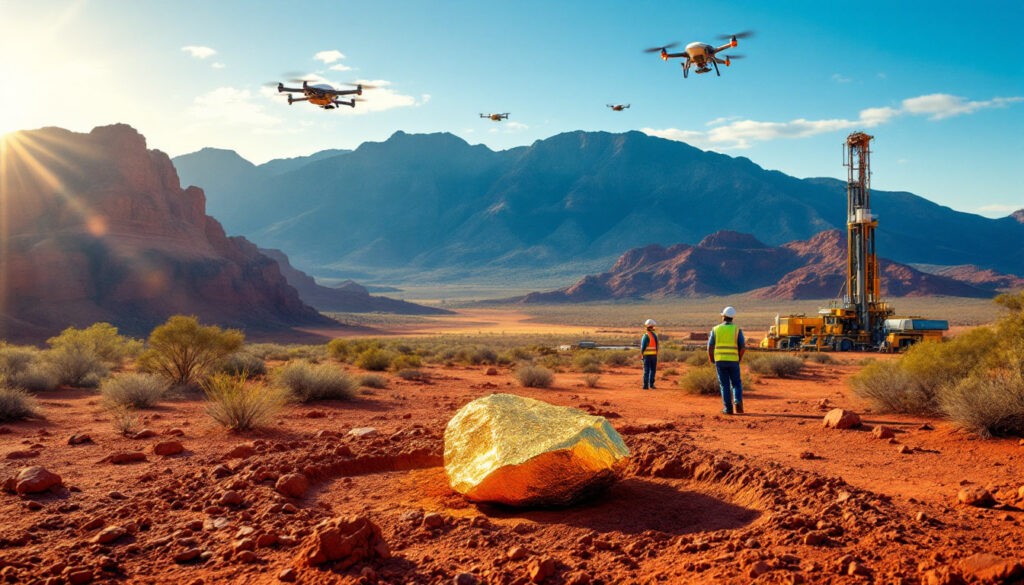How Has Exploration in Australia Evolved Over Time?
Australia's mineral exploration history spans an impressive 180 years, characterized by distinct waves of discovery that have shaped the nation's mining landscape. According to MinEx Consulting data, Victoria accounts for 8% of all significant discoveries in Australia's rich mining history, highlighting the state's historical importance despite its relatively small geographical footprint.
Perhaps most remarkably, half of all significant discoveries in Australia have been made since 1987, demonstrating how modern exploration techniques have accelerated discovery rates in recent decades. This statistic underscores the evolution of exploration in Victoria and Australia from rudimentary prospecting to sophisticated geological modeling and geophysical techniques.
Australia's geological bounty encompasses 1,753 significant deposits across a diverse mineral spectrum, cementing its status as one of the world's premier mining jurisdictions. These deposits meet specific size thresholds (such as >100,000 ounces of gold or >10,000 tonnes of nickel) that qualify them as commercially significant.
The Long Wave of Discovery History
The evolution of Australian mineral exploration can be viewed through several distinct historical periods. The initial waves began with the NSW and Victorian gold rushes of the 1850s-1860s, which dramatically transformed Australia's economy, population distribution, and global standing.
The Western Australian gold rush followed as a second major wave, expanding Australia's mining footprint westward and establishing foundations for what would become Kalgoorlie's Golden Streets: Australia's Richest Gold Rush Town. These early discoveries relied primarily on surface prospecting, with limited technological assistance.
Subsequent mining booms in the 1960s-70s focused on gold and nickel, while the 2005-12 period saw tremendous exploration activity driven by China's insatiable demand for resources. This China-driven boom represented a fundamental shift, as exploration increasingly targeted bulk commodities to feed Asian industrialization.
Modern discoveries benefit from advanced technologies like AI-driven geological modeling, drone surveying, and deep-penetrating geophysical methods that were unavailable to earlier prospectors, explaining the accelerated discovery rates in recent decades.
Historical Gold Rush Periods
Victoria's golden era began with the 1851 discoveries at Ballarat and Bendigo, triggering one of history's greatest gold rushes. These finds transformed a pastoral colony into a global mining center virtually overnight. By the late 19th century, Victoria had produced nearly 2,300 tonnes of gold – approximately one-third of the world's output at that time.
While Victoria's prominence faded after the 1930s, Western Australia emerged as Australia's gold mining focal point. The discovery of Kalgoorlie's Golden Mile in 1893 established foundations for what remains one of the world's richest gold mining districts.
The cyclical nature of exploration success continued through subsequent decades, with technological advances enabling discoveries at increasing depths and in more challenging geological environments. This historical perspective demonstrates how exploration success has continually shifted geographically across Australia while becoming progressively more sophisticated in methodology.
What Are the Current Exploration Expenditure Trends?
Global Exploration Spending Patterns
Australia has consistently been a global exploration powerhouse, accounting for 14% of world exploration spending between 2014-2023. This substantial contribution places Australia fourth globally in exploration investment, representing approximately 18% of the worldwide total as of 2023.
Global exploration expenditure has followed dramatic cyclical patterns, peaking at $42.6 billion in 2012 during the height of the China-driven commodities boom. However, following this peak, spending crashed to just $13.3 billion in 2016 – a devastating 69% decline that forced many junior explorers out of business.
As of 2023, global exploration spending stands at $15.8 billion, having recovered somewhat but still far below previous heights. This reduced spending reflects a more cautious approach to navigating mining investments, strategies, and geological insights in an era of heightened economic uncertainty and tightening capital markets.
Exploration investment flows heavily toward geologically proven jurisdictions with favorable regulatory environments, explaining Australia's continued attraction despite cyclical downturns. The country's stable political environment, established mining codes, and history of major discoveries continue to attract global investment even during industry contractions.
Australian Exploration Expenditure by Commodity
Total Australian exploration spending has plateaued at approximately A$4 billion annually in recent years, reflecting a mature exploration landscape with increasing focus on brownfield expansion rather than greenfield discovery. This plateau masks significant shifts in commodity focus, however.
Recent data reveals a notable pullback in gold and base metals exploration despite strong gold prices, with companies demonstrating more selective targeting. This trend suggests companies are pursuing quality over quantity, focusing resources on prospects with higher probability of success.
Perhaps the most significant shift has been the dramatic rise in the "Other" category, primarily driven by lithium and rare earth elements (REE). This surge reflects rapidly growing demand for battery metals and critical minerals essential for the green energy transition and advanced technologies.
Exploration expenditure remains highly cyclical, with Australia experiencing a 63% drop between the 2012 peak and 2018. This extreme volatility creates significant challenges for the exploration sector, particularly for junior companies without producing assets to provide cash flow during downturns.
Victoria's Exploration Landscape
Gold dominates Victoria's exploration focus, accounting for 72% of the state's total exploration expenditures over the last three decades. This gold-centric approach reflects Victoria's historical association with the precious metal and the continued belief in its undiscovered potential.
Victoria experienced a remarkable 6.6× increase in exploration spending between 2016 and 2021, a growth surge triggered primarily by the discovery of the high-grade Swan Zone at Fosterville gold mine in 2016. This spectacular find, with grades exceeding 30 grams per tonne gold, reignited interest in Victoria's gold potential after decades of relatively modest activity.
Current exploration spending in Victoria stands at A$107 million (2024), a significant figure but dwarfed by Western Australia's dominant A$2,539 million. This disparity reflects both Victoria's smaller geographical area and WA's superior success in attracting exploration investment across multiple commodities.
According to Richard Schodde of MinEx Consulting, "The main game in town is Western Australia… Victoria accounted for 4% of total spend." This statement highlights the continued concentration of exploration dollars in WA, while also noting Victoria's modest but meaningful contribution to the national exploration landscape.
Exploration Intensity by Region
When considering exploration intensity rather than absolute dollars, Victoria presents a different picture. The state accounts for just 3.1% of Australia's available land area but until recently was one of the most intensively explored states on a per km² basis.
Western Australia dominates Australia's exploration landscape, accounting for 63% of total spending over the last decade. This dominance reflects WA's proven mineral endowment, established infrastructure, and relatively supportive regulatory environment.
Victoria accounted for only 4% of total Australian exploration spending during this period, yet delivered 7% of discoveries, suggesting higher efficiency in converting exploration dollars to discoveries. This superior conversion rate hints at Victoria's geological potential despite its more modest share of spending.
The concentration of exploration spending in specific regions highlights how geological prospectivity, infrastructure access, and regulatory and ESG challenges in the mining industry strongly influence investment decisions. Companies increasingly focus resources on jurisdictions with demonstrated potential and supportive frameworks rather than spreading investment geographically.
Who Is Making the Discoveries in Australia?
Junior vs. Major Companies
The dominant trend in Australian mineral discovery since the 1990s has been the rise of Junior Companies as the primary drivers of new finds. This shift reflects the changing dynamics of the exploration sector, with Juniors bringing agility and risk tolerance that larger companies often lack.
Over the last decade, Junior Companies accounted for a remarkable 79% of all discoveries in Australia. This statistic highlights how the exploration landscape has fundamentally transformed from earlier eras when Major companies led discovery efforts.
Major and Intermediate Companies combined accounted for only 13% of discoveries during this period, despite controlling significantly larger budgets and land holdings. This disparity suggests that organizational factors such as decision-making flexibility and risk appetite may be more important than financial resources in driving discovery success.
The trend toward Junior-led discovery has been consistent and growing, reflecting structural changes in how the mining industry approaches exploration risk. Major companies increasingly prefer to acquire discoveries rather than make them, effectively outsourcing exploration risk to the Junior sector.
Discovery Rate Trends
Australia's discovery rate has flat-lined at approximately 14 significant deposits per year, despite increasing exploration expenditure. This trend suggests diminishing returns on exploration investment, likely reflecting the increasing challenge of finding near-surface deposits in mature exploration terranes.
Recent years have seen a noticeable focus shift toward copper and lithium discoveries, reflecting changing market demands and the critical importance of these metals for the energy transition. This pivot demonstrates how exploration focus follows commodity price signals and long-term demand projections.
Western Australia continues to lead in the number of discoveries across all states, reinforcing its status as Australia's premier mining jurisdiction. The state's geological diversity, established infrastructure, and supportive regulatory environment create favorable conditions for exploration success.
Victoria accounted for 7% of discoveries over the last decade, punching above its weight relative to its 4% share of exploration spending. This efficiency ratio suggests Victoria remains an attractive exploration jurisdiction despite its smaller size and more mature exploration history.
The Relationship Between Spending and Discoveries
The relationship between exploration spending and discovery success has become increasingly challenging. While total exploration spending has increased substantially over time, the number of discoveries has not kept pace, indicating declining efficiency in exploration efforts.
This diminishing return on investment likely reflects the increasing difficulty in making new discoveries as the most obvious deposits have already been found. Modern explorers must contend with deeper cover, more complex geology, and the need for more sophisticated and expensive exploration technologies.
The discovery rate has not matched the growth in exploration expenditure, creating pressure on companies to improve targeting methodologies and technological approaches. This gap has driven innovation in exploration techniques, from advanced geophysics to digital transformation in mining innovations in target generation.
Companies that successfully navigate this changing landscape typically employ disciplined targeting approaches, embrace new technologies, and maintain geological expertise – factors that can help overcome the headwinds of declining discovery rates.
What Is the Depth Profile of Recent Discoveries?
Trends in Depth of Cover
A clear trend in Australian mineral exploration is that discoveries are progressively getting deeper over time for both base metals and gold. This depth migration reflects the historical pattern where shallower, more easily identified deposits were discovered first, leaving deeper targets for modern explorers.
Over the last decade, the average depth of cover for gold discoveries was 120 meters in Australia, compared to 89 meters globally. This statistic indicates that Australian discoveries tend to be deeper than the global average, highlighting both the challenge and opportunity presented by Australia's covered terranes.
The increasing depth trend necessitates more sophisticated exploration techniques, including advanced geophysical methods like 3D seismic surveys that can penetrate hundreds of meters below surface. These technologies come with significantly higher costs, contributing to the reduced efficiency of exploration spending.
Most greenfield deposits continue to be found near-surface, reflecting the reality that deeper exploration remains challenging and expensive. The economics of deeper exploration typically require higher grades to justify the increased discovery and development costs.
Brownfield discoveries generally occur at greater depths, often representing extensions or satellite deposits around existing operations. This pattern reflects the intensive exploration that naturally occurs around producing mines, where infrastructure and geological knowledge provide advantages that justify deeper targeting.
Fosterville's Swan Zone exemplifies this trend, representing a deep, high-grade discovery that transformed an existing operation. Such discoveries demonstrate that substantial opportunities remain at depth in mature mining districts, particularly where new geological models or exploration technologies enable fresh insights.
What Value Do Discoveries Create?
Tier Classification of Discoveries
The mineral industry classifies discoveries into tiers based on their economic value, with Tier 1 deposits representing the most significant finds. According to MinEx Consulting data, five Tier 1 deposits were found in Australia over the last decade (2014-2023).
These elite discoveries include Julimar (Ni-PGE), Hemi (Au), Wodgina (Li), Mt Holland (Li), and Swan (Au). The inclusion of two lithium deposits in this list highlights the growing importance of battery metals in the global mining landscape.
Eight Tier 2 deposits were also discovered during this period, representing significant but not world-class finds. These deposits, valued between $200 million and $1 billion, form an important component of the exploration value chain.
Tier 1 and 2 discoveries collectively account for 67% of the value created from exploration, demonstrating how a relatively small number of major discoveries drive most of the economic value in the exploration sector. This concentration of value underscores the "home run" nature of the exploration business.
Economic Value of Discoveries
The expected value of Tier 1 discoveries averages approximately US$2,663 million per discovery, highlighting the transformative economic impact these world-class deposits can have. These rare finds can create entire mining districts and support decades of production.
Tier 2 discoveries, while less spectacular, still deliver substantial value at approximately US$666 million per discovery. These deposits often form the backbone of mid-tier mining companies and can provide decades of profitable operation.
Tier 3 discoveries, averaging US$107 million in value, typically represent smaller deposits that may serve as satellite operations or provide value through acquisition by larger companies. While modest individually, the cumulative value of these smaller discoveries remains significant.
The total value created from Australian discoveries between 2014-2023 reached an impressive US$27.8 billion, demonstrating the substantial economic contribution of the exploration sector despite its inherent risks and challenges.
Return on Exploration Investment
Australia spent US$22.0 billion on exploration over the last decade, generating discoveries valued at US$27.8 billion. This yields a "Bang per Buck" ratio (value created/cost) of 1.26, indicating that exploration in Victoria and Australia remains a value-creating endeavor despite increasing challenges.
Victoria emerged as the top-performing state with an impressive "Bang per Buck" ratio of 4.16, far exceeding all other Australian jurisdictions. This exceptional performance largely reflects the discovery of the high-grade Swan Zone at Fosterville, which created disproportionate value relative to exploration spending.
When compared globally, Victoria's exploration efficiency ratio of 4.16 stands well above international benchmarks such as Canada's 1.05. This superior performance highlights Victoria's geological potential despite its smaller size and more mature exploration history.
The positive return on exploration investment across Australia demonstrates the sector's continued ability to create economic value, even as discovery becomes more challenging. This value creation supports continued investment in exploration despite the high-risk nature of the activity.
How Does Victoria Compare in Business Risk?
Fraser Institute Rankings
According to the Fraser Institute's annual survey, Victoria ranked 48th out of 86 countries/regions in the 2023 Policy Potential Index, reflecting a moderate level of business risk for exploration and mining investment. This relatively low ranking represents a concern for Victoria's mining future.
Victoria's business risk ranking has deteriorated in recent years, creating potential headwinds for exploration investment. This downward trend contrasts with the state's excellent geological potential and historical exploration success.
Victoria now has the worst business risk ranking among all Australian states, potentially hampering its ability to attract exploration investment despite its proven mineral endowment. This ranking gap highlights the importance of regulatory frameworks in driving investment decisions.
Key concerns identified in the Fraser Institute survey include environmental regulations and administration of regulations, areas where Victoria scores particularly poorly. These factors can significantly impact exploration timelines and costs, deterring investment despite favorable geology.
Business Risk Factors
Victoria performs well in some categories but poorly in others, creating a mixed investment environment. Strengths include infrastructure access and geological database quality, while weaknesses center on regulatory complexity and environmental requirements.
Areas needing improvement include environmental regulations and regulatory administration, which survey respondents consistently identified as barriers to investment. These factors create uncertainty and increase costs, potentially deterring exploration spending despite Victoria's geological attractiveness.
Recent policy changes implemented in 2024-2025 have aimed to streamline Victoria's mining permitting process, though their impact remains to be fully assessed. These reforms respond to industry feedback about regulatory barriers to exploration success.
The contrast between Victoria's superior "Bang per Buck" ratio and its poor business risk ranking creates an interesting tension for potential investors. Companies must weigh exceptional geological opportunity against heightened regulatory challenges when making investment decisions.
What Is the Outlook for Exploration?
Junior Company Financial Health
Junior companies account for 70-80% of all exploration activities in Australia, making their financial health critical to the sector's overall prospects. Currently, this vital segment faces significant financial headwinds.
Cash reserves for junior exploration companies have fallen substantially in the last two years, constraining their ability to maintain active exploration programs. This decline reflects challenging capital market conditions, particularly for companies in certain commodity sectors.
In-field exploration and development expenditures are cut the most during downturns, as companies preserve capital for essential corporate functions. This pattern results in reduced drilling activity – the lifeblood of new discoveries – during market contractions.
Companies are struggling to raise fresh capital, particularly in certain commodity sectors perceived as less favorable by investors. This funding challenge has forced many juniors to reduce exploration activity by up to 40% in 2024, potentially impacting future discovery rates.
Future Prospects
The 1-3 year outlook for exploration in Australia is "mixed," with significant headwinds in capital markets counterbalanced by strong long-term demand fundamentals for key minerals. This uncertainty creates both challenges and opportunities for well-positioned companies.
Evidence suggests the industry is entering a down-cycle, with reduced capital availability and more selective investor interest. Companies with producing assets or exceptionally promising projects will likely weather this cycle better than pure greenfield explor
Interested in Discovering the Next Major Mineral Find?
Stay ahead of the market with Discovery Alert's proprietary Discovery IQ model, providing real-time notifications of significant ASX mineral discoveries and transforming complex data into actionable investment insights. Explore our dedicated discoveries page to understand how mineral discoveries can lead to substantial market returns and begin your 30-day free trial today.




